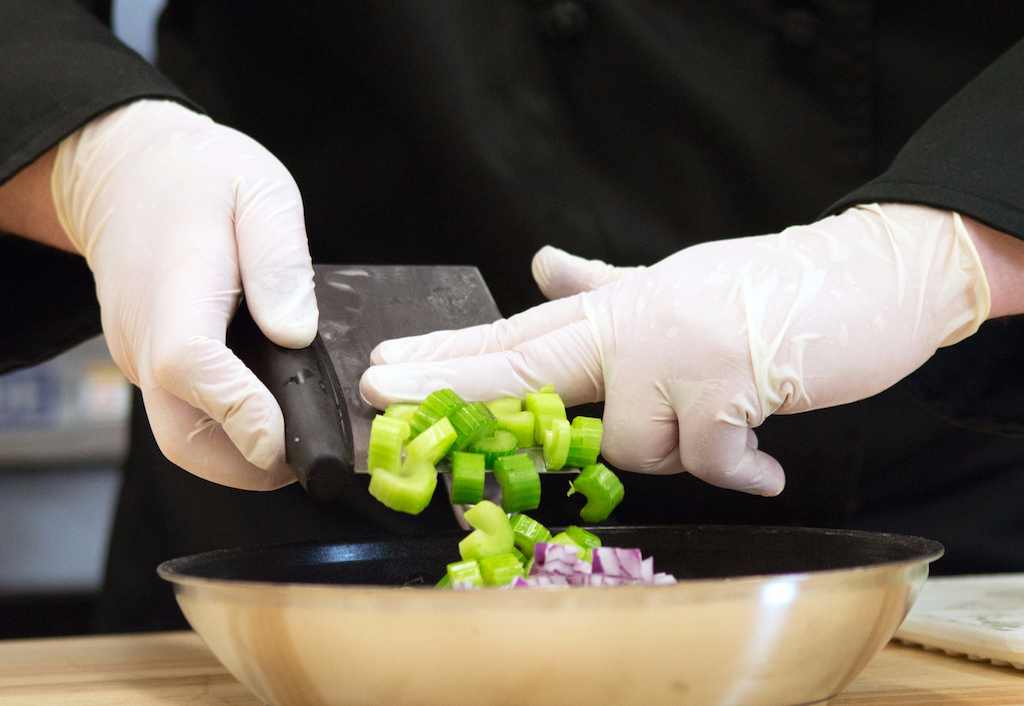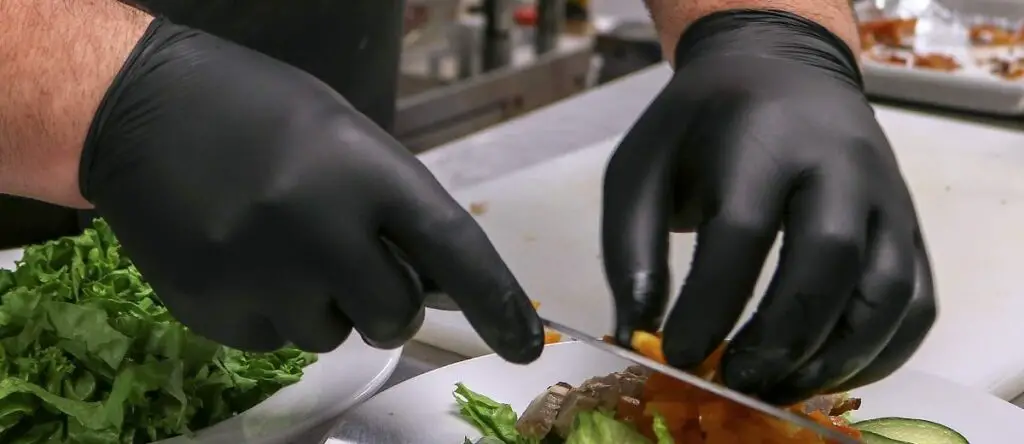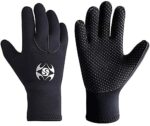Gloves are important in a variety of sectors because they act as a barrier between hands and other objects. Disposable gloves are used on a daily basis in the food and beverage sector to avoid the transmission of germs and the contamination of consumables.
The most prevalent reason for using gloves while handling food is to guard against foodborne infections. There are hundreds of foodborne infections that cause people to become ill after eating contaminated food. Fortunately, with the proper gloves, this is an avoidable problem.
You cannot use surgical gloves for food because they are sterile, meaning they go through various chemical processes for sterilization which makes them inedible. Also, sterile gloves are mostly utilised in wound care and surgical operations. Handling food does not need the use of surgical gloves.

Importance of using gloves while handling food
1.) Gloves assist to reduce contact with food and prevent the spread of bacteria that can cause contamination and disease. They protect consumers from germs and bacteria that may be present on the staff’s hand.
2.) Gloves, in addition to avoiding the spread of bacteria, protect your hands from burning while cutting spicy foods. They avoid acidic liquids from getting into cuts on your hands and also guard your nails.
3.) Strong food smells, such as garlic and seafood, will not cling to your hands as much when you wear gloves.
4.) Employees can avoid cross-contamination from different types of food items by wearing distinct pairs of gloves while working with raw meats. This helps to avoid the spread of infections such as salmonella.
What are the standard requirements for food gloves?
The Food Code of the United States Food and Drug Administration (FDA) mandates workers to use gloves or utensils while handling food items that are to be consumed instantly.
According to the FDA, authorised gloves must be composed of a material that is generally recognised as safe for use in food and food packaging.
Usually there are two types of medical gloves, surgical grade gloves and exam grade gloves. We have already discussed what surgical gloves are, but examination gloves are those that are used for non-surgical medical operations.
They are now employed in a variety of different sectors, including food processing and handling, due to their higher quality.
Examination grade gloves must pass a number of technical tests in order to fulfil the FDA’s safety criteria. Gloves are evaluated for puncture and abrasion resistance, as well as pressure and elasticity and chemical substance resistance.
An AQL(Acceptable Quality Level) of 2.5 or less is also required for examination grade gloves.
And since there is no AQL requirement for food service gloves, you must take personal precautions to improve your food safety protocols and avoid food-borne diseases by using examination gloves.
It is critical to understand the AQL while selecting food handling gloves. The lower the AQL value, the better the barrier protection you’ll have for your hands and meals.
So what should you look for in your food handling gloves?
1.) Understand the AQL test findings and make purchases based on them.
2.) Select disposable gloves with an AQL of 2.5 or less. Purchase gloves that are suited for food handling.
3.) Be wary of low-cost gloves as they may not be of a good quality.
4.) Purchase only from reputed providers that have quality control measures in place.
Different types of glove material that can be used while handling food.
Today’s glove product line is so extensive that it may appear difficult to select the appropriate gloves. Gloves should be chosen primarily based on the type of the activity and the food involved.
Here’s a quick rundown of some of the most major benefits and drawbacks of various glove materials designed to come into touch with food:
| Latex | Vinyl | Nitrile |
| Excellent elasticity and tear resistance.
Extremely pleasant to wear. Resistant to moisture. Retains elasticity even in cold conditions. |
It is free of latex, therefore, no allergies.
Ideal for sensitive skin. Weather resistant which makes them quite versatile. |
Mechanical resistance is exceptional.
Extremely high resistance to fats, oils. Good elasticity |
What are the disadvantages to consider if we choose one among these gloves?
| Latex | Vinyl | Nitrile |
| Resistant to fats and oils to a limited extent.
Has a low resilience to withering, climate, and temperature. Can cause allergies. |
Mechanical resistance is low.
Becomes flaky. Loses elasticity over time. |
Takes a longer time to breakdown. |
Although, all of these three gloves can be used in the food industry, if you can choose any one out of the three, then the winner would of course be nitrile.
Latex was the industrial norm during the later part of the twentieth century, but this created a new set of issues.
Those who handled the food as well as those who ate it were at a significant risk of latex allergies, which might result in fatal responses.
With the introduction of nitrile disposable gloves, latex was gradually driven out of the market, and nitrile gloves took its position as the new go-to for suppliers and customers.
Nitrile is a lot safer solution for all users and is more resistant to a wide range of contaminants that latex was not.
Why is nitrile a better choice in the food industry?
Food poisoning from inappropriate food handling and the spread of food-borne diseases have been progressively declining, and gloves have played a significant role in this trend.
Nitrile gloves have been a big part of that development, thanks to their toughness and resilience, as well as the decrease in latex on the market.

An enterprise that was formerly limited to just the medical field has expanded into a variety of areas, with the food industry by far the world’s second largest end consumer of nitrile gloves.
Because of the availability, decent price, strength, and longevity of nitrile, many business owners have decided to supply it to their employees, and as a result, we are all safer.
How can you tell if a glove is food safe?
1.) First of all, a glove will have a FDA or HACCP third party certification mentioned on the box or website.
2.) Powder-free gloves should be used by food service workers and at home in food preparation. Powdered gloves increase the danger of cross contamination. This is not a concern with powder-free gloves.
3.) Your gloves should be durable so that there are no cuts and tears in between your work while cooking and preparing meals.
Are food service gloves the same as medical gloves?
Usually, exam grade gloves like nitrile and non powdered latex are used in the food industry. However, there are considerable differences between the two.
Food preparation gloves are intended to do a range of duties and are not intended to be worn for an extended period of time. They are certified for use in food preparation and handling, as well as other light duty and low risk jobs.
Whereas medical grade gloves are often used for non-surgical procedures such as medical examinations and are approved for usage in hospitals, nursing homes, or laboratory settings. They are also used when there is a chance of contact with body fluids or pollutants.
Recommended nitrile, latex and vinyl gloves for food handling
1.) Klex Nitrile Exam Gloves
These powder free gloves are great in terms of quality and performance. It is comfortable and durable.
Check it out here-
- Strong Medical Grade Nitrile Gloves, Use for Multipurpose Usage Included Medical, Dental, Laboratory, Food, Industrial, Cleaning
- Powder free minimizes the risk of contamination and infection
- Meets and exceeds ASTM standards for quality and performance.
Prices pulled from the Amazon Product Advertising API on:
Product prices and availability are accurate as of the date/time indicated and are subject to change. Any price and availability information displayed on [relevant Amazon Site(s), as applicable] at the time of purchase will apply to the purchase of this product.
2.) MedPride Nitrile Gloves
For people with latex allergy, this is a great alternative as it is ideal for sensitive skin. Provides protection against contamination without compromising on comfort.
Check it out here-
- The ideal solution for individuals sensitive to natural rubber latex and donning powder.
- Comfortable fit with textured fingertips for excellent tactile sensitivity.
- Extraordinary strength, stretchable durability and puncture resistance with premium iris blue color.
- Commonly used by law enforcement professionals, tattoo artists, physicians and first responders.
Prices pulled from the Amazon Product Advertising API on:
Product prices and availability are accurate as of the date/time indicated and are subject to change. Any price and availability information displayed on [relevant Amazon Site(s), as applicable] at the time of purchase will apply to the purchase of this product.
3.) Springcare Latex Gloves
These powder free latex gloves provide good value for money with their anti-tear and abrasion resistant qualities.
Check it out here-
- Powder Free Latex Gloves
- Ambidextrous - perfect for right or left handed use | Perfect fit for optimal protection and comfort.
- Anti-tear, Anti-Rip, Anti-Abrasion properties | Beaded cuff to increase tear resistance.
- Food Processing, Repairs, Pet Care, Auto Care, and much more!
Prices pulled from the Amazon Product Advertising API on:
Product prices and availability are accurate as of the date/time indicated and are subject to change. Any price and availability information displayed on [relevant Amazon Site(s), as applicable] at the time of purchase will apply to the purchase of this product.
4.) Gorilla Supply Vinyl Gloves
These gloves are ideal to protect your hands from dirt and debris. With a comfortable fit, they protect your hands from a variety of outside factors in order to keep your hands as dry and sanitary as possible.
Check it out here-
- Vinyl gloves 100 gloves/ box
- Safe for food contact - Material meets the requirements for food contact
- Extra Strength, 4mil
- Great for food service, healthcare, home cleaning, crafting, etc.
Prices pulled from the Amazon Product Advertising API on:
Product prices and availability are accurate as of the date/time indicated and are subject to change. Any price and availability information displayed on [relevant Amazon Site(s), as applicable] at the time of purchase will apply to the purchase of this product.
Conclusion
When it comes to selecting gloves for food related work, there are various options no doubt, but making a wise decision is helpful in the wrong run.
Latex and vinyl are no doubt good, but nitrile is something that is an undefeated champion when it comes to the final choice.
We have included all that is necessary for you to understand which glove you should choose according to the work. However, when it comes to the food industry, go for nitrile as the first option.












